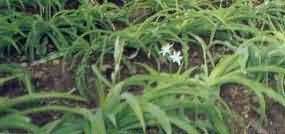सफेद मूसली कैसे उगाऐ।
 Safed Musli is a medicinal plant that is native to India. Its botanical name is chlorophytum borivilianum and belongs to Liliaceae family.
Safed Musli is a medicinal plant that is native to India. Its botanical name is chlorophytum borivilianum and belongs to Liliaceae family.
Safed Musli is a herb with linear leaves appearing over ground with the advent of summer rains. Flowers white. It perenates by fleshy roots/root-tubers. Tuberous root is used in ayurvedic medicin. Cultivation of safed musli is more profitable than many of the traditional crops.
CULTIVATION OF SAFED MUSLI:
Safed Musli can be grown in Foot Hills of Uttaranchal, Himachal Pradesh & Uttar Pradesh, Madhya Pradesh, Andhra Pradesh, Tamil Nadu, Kerala, Karnataka, Rajasthan, Gujarat and Maharashtra .
SOIL AND CLIMATE
Safed Musli requires well drained loamy to sandy loam soils rich in organic matter. Warm and humid climatic condition with good amount of soil moisture during the growing season favour luxuriant vegetative growth and facilitate fleshy root development.
NURSERY RAISING AND PLANTING OF SAFED MUSLI:
It could be propagated through seeds as well as by vegetative means (root-stock bearing buds or growing points).
By seeds:
The seeds are black in colour and with angular edges. It take 12-16 days to sprout. The seeds should be sown in a very well prepared seed bed which is heavily manured by using FYM or leaf litter in the first or second week of June and adequate moisture should be continuously maintained during absence of rain in early part of the season. The seedlings can be transplanted in the field during the next Kharif season only at 30x15 cm spacing because the development of plants as well as roots by means of seeds in the first year is not vigorous enough as compared the vegetatively propagated plants.
Vegetative propagation:
The initiation of sprouts of fleshy roots starts in mid May but sometimes it could be as early as the last week of April in stored material. In the forest seedlings emerge out from the ground within 4-6 days after receipt of rains. However, for the purpose of raising plants in the field either the sprouted seedlings should be collected from the forest between 10 to 30 days after receipt of rains and transplanted in the field or fleshy root bunches should be taken out from the ground or storage place in mid of May.
Even a small, 1 cm long and slightly shrinken fleshy roots or root stocks has a capacity to reproduce into new plants. These fleshy roots sprout from second week of May to second week of June. The sprouted fleshy propagules should be planted in the field in first or second week of June, followed by irrigation.
The practice of planting on top of the ridges of 15-20 cm height at a row distance of 30x15 cm is found adequate for obtaining commercial yield. It is estimated that 250-300 kg of root stocks will be required for planting one ha land. Safed Musli could be easily intercropped in between maize rows.
MANURE AND FERTILISER
The use of 10-15 ton of FYM/ha provide good nutrient status to the substratum for supporting healthy plant growth.
IRRIGATION
The crop may be sown after receipt of rains. If there is no rains after sowing of fleshy root propagules and its transplanting then one irrigation be provided immediately. Later, when soil moisture get reduced in the fields, irrigation may be done after 10 to 15 days interval.
WEEDING
One to two weeding-cum-hoeings are needed to keep the soil porous and free of weedy growth.
HARVESTING/POST-HARVESTING IN SAFED MUSLI
The crop matures in about 90 days under cultivation. At maturity the leaves start yellowing and ultimately dry up from the collar part and fall down. The crop could thus be harvested when leaves have dried which occurs in the months of September/October. During digging of plants, fleshy root bunches should be lifted form the soil.
The harvested fleshy roots are cleaned and skin is removed. The white musalitubers obtained are dried spread in the shade for about 4-7 days to dry-out its moisture.
YIELD & PRICE
About ten quintals of fleshy root (wet) per hectare, is collected. This, after processing and drying is reduced to 200 kg (about 20% of wet root wt). In the domestic market, the rates ranges between Rs 800 to Rs 1800 per kg depending on the quality of the product.
Caution:
The number of farmers interested in musli growing is increasing very rapidly but due to lack of expert knowledge about cultivation, particularly harvesting and post harvest processing, the middlemen are cheating the farmers. Most of the time farmer is paid low price by the middlemen, in the name of poor quality, color and size. Therefore utmost care should be taken while undergoing into some buyback agreement, with any Farm/ Consultant or buyer, about the quality parameters.
Source: IARI Krishi Vigyan Mela
